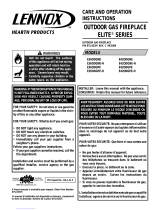
2
NOTE: DIAGRAMS & ILLUSTRATIONS NOT TO SCALE.
CONGRATULATIONS!
In selecting this LENNOX Direct-Vent Gas Appliance you have chosen the finest and most
dependable fireplace to be found anywhere. A beautiful, prestigious, alternative to a
wood burning fireplace. Welcome to a Family of tens of thousands of satisfied LENNOX
Fireplace Owners.
Please read and carefully follow all of the instructions found in this manual. Please pay
special attention to the safety instructions provided in this manual. The Homeowner's
Care and Operation Instructions included here will assure that you have many years of
dependable and enjoyable service from your LENNOX product.
GENERAL INFORMATION
Note: Installation and repair should be performed
by a qualified service person. The appliance
should be inspected annually by a qualified pro-
fessional service technician. More frequent in-
spections and cleanings may be required due to
excessive lint from carpeting, bedding material,
etc. It is imperative that the control compart-
ment, burners and circulating air passage ways
of the appliance be kept clean.
S'assurer que le brùleur et le compartiment
des commandes sont propres. Voir les in-
structions d'installation et d'utilisation qui
accompagnent l'appareil.
Provide adequate clearances around air open-
ings and adequate accessibility clearance for
service and proper operation. Never obstruct
the front openings of the appliance.
Due to high temperatures the appliance should
be located out of traffic and away from furni-
ture and draperies. Locate furniture and win-
dow coverings accordingly.
Direct-Vent appliances operate with the com-
bustion chamber completely isolated from the
inside atmosphere. All air for combustion is
brought in from the outside and exhaust gases
are vented through the same direct vent, vent
system.
The millivolt appliances are designed to oper-
ate on either natural or propane gas. A millivolt
gas control valve with piezo ignition system
provides safe, efficient operation. External
electrical power is required to operate the
optional electrically powered components if
installed. Electrical power must be wired dur-
ing appliance installation.
The electronic appliances are designed to op-
erate on either natural or propane gas. An
electronic intermittent pilot system provides
safe, efficient operation. External electrical
power is required to operate these units.
These appliances comply with National Safety
Standards and are tested and listed by Omni-
Test Laboratories (Report No. 116-F-05-5) to
ANSI Z21.88-2002 (in Canada, CSA-2.33-
2002), and CAN/CGA-2.17-M91 in both USA
and Canada, as vented gas fireplace heaters.
The Installation must conform to local codes
or, in the absence of local codes, with the
National Fuel Gas Code, ANSI Z223.1/NFPA
54
, or the
Natural Gas and Propane Installa-
tion Code, CSA B149.1
. The appliance, when
installed, must be electrically grounded in
accordance with local codes or, in the ab-
sence of local codes, with the
National Elec-
trical Code, ANSI/NFPA 70
, or the
Canadian
Electrical Code, CSA C22.1
.
DO NOT ATTEMPT TO ALTER OR MODIFY
THE CONSTRUCTION OF THE APPLIANCE OR
ITS COMPONENTS. ANY MODIFICATION OR
ALTERATION MAY VOID THE WARRANTY,
CERTIFICATION AND LISTINGS OF THIS UNIT.
TABLE OF CONTENTS
Introduction............................................ page 2
General Information................................ page 2
Operation/Care of Your Appliance .......... page 3
Variable Flame Adjustment ..................... page 4
Glass Cleaning........................................ page 5
Maintenance ........................................... page 5
Front Glass Enclosure Panel,
Removal and Installation ...................... page 5
Maintenance Schedule............................ page 6
Burner Adjustments................................ page 7
Flame Appearance and Sooting .............. page 7
Adjustment ............................................. page 7
Log Placement........................................ page 8
Decorative Volcanic Stone Placement .... page 9
Millivolt Appliance Checkout................... page 9
Electronic Appliance Checkout ............... page 9
Accessory Components.......................... page 9
Wiring Diagrams .................................... page 14
Warranty................................................. page 14
Replacement Parts ................................. page 14
Product Reference Information .............. page 14
Lighting Instructions – Millivolt.............. page 16
Lighting Instructions – Electronic........... page 18
Troubleshooting Guide – Millivolt ............ page 20
Troubleshooting Guide – Electronic ......... page 21
Replacement Parts List ........................... page 22
WARNING: THESE FIREPLACES ARE
VENTED HEATERS. DO NOT BURN
WOOD OR OTHER MATERIAL IN THESE
APPLIANCES.
WARNING: IMPROPER INSTALLATION,
ADJUSTMENT, ALTERATION, SERVICE
OR MAINTENANCE CAN CAUSE INJURY
OR PROPERTY DAMAGE. REFER TO
THIS MANUAL. FOR ASSISTANCE OR
ADDITIONAL INFORMATION CONSULT
A QUALIFIED INSTALLER, SERVICE
AGENCY OR THE GAS SUPPLIER.
WARNING: ELECTRONIC MODELS OF
THESE APPLIANCES ARE EQUIPPED
WITH A THREE-PRONG (GROUNDING)
PLUG UTILIZED IN CONNECTING THE
ELECTRONIC COMPONENTS TO THE
JUNCTION BOX IN THE LOWER COM-
PARTMENT. THIS GROUNDING PLUG
PROVIDES PROTECTION AGAINST
SHOCK HAZARD AND SHOULD BE
PLUGGED DIRECTLY INTO THE PROP-
ERLY GROUNDED THREE-PRONG RE-
CEPTACLE. DO NOT CUT OR REMOVE
THE GROUNDING PRONG FROM THE
PLUG.
INTRODUCTION
The Fireplace models covered in this manual
are Direct-Vent sealed combustion gas fire-
place heaters designed for residential applica-
tion.































